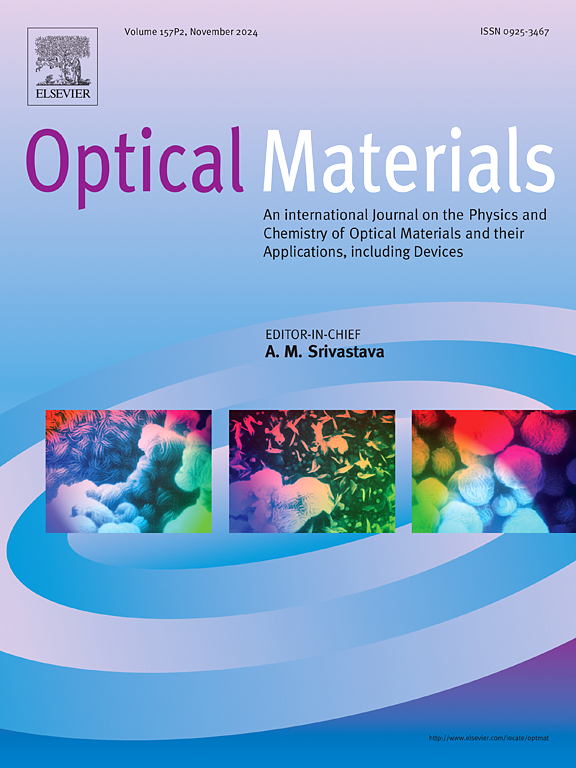Investigation of the TeO2–ZnO–La2O3-WO3 tellurite glass: a promising visible and Mid-infrared acousto-optic material
IF 4.2
3区 材料科学
Q2 MATERIALS SCIENCE, MULTIDISCIPLINARY
引用次数: 0
Abstract
A novel 70TeO2–15ZnO-6.5La2O3-8.5WO3 tellurite glass (mol%, TZLW) was synthesized via melt-quenching. The potential of this glass as an acousto-optic (AO) material in the visible to Mid-infrared range (0.40–5.4 μm) was evaluated. With a large diameter (50 mm), low hydroxyl absorption (0.2 cm−1 at about 3.4 μm) and high optical homogeneity (Δn = 5.941 × 10−4), the glass shows great potential for high-performance optical devices. Comprehensive characterization of optical, thermomechanical, laser-induced damage threshold (LIDT) and AO properties was performed, with particular emphasis on their correlation with structural features revealed by Raman spectrum. The measured acoustic attenuation at 100 MHz was 3.94 dB/cm, corrected to 3.31 dB/cm using an interfacial reflection correction method - the first reported application of such methodology in AO glass systems, to the best of our knowledge. The LIDT measured at 800 nm (130 fs pulse width, 1 kHz repetition rate) reaches 0.572 J/cm2, which is 4 times greater than commercial As2S3 glass. Moreover, the AO figure of merit M2 reaches 37.2 × 10−15 s3/kg at 1550 nm, exceeding all previously reported tellurite glasses and being 24 times greater than commercial quartz glass.
TeO2-ZnO-La2O3-WO3碲酸盐玻璃的研究:一种有前途的可见和中红外声光材料
采用熔融淬火法制备了新型70TeO2-15ZnO-6.5La2O3-8.5WO3碲酸盐玻璃(mol%, TZLW)。在可见光到中红外(0.40 ~ 5.4 μm)范围内评价了该玻璃作为声光材料的潜力。该玻璃直径大(50 mm),羟基吸收低(约3.4 μm处为0.2 cm−1),光学均匀性高(Δn = 5.941 × 10−4),在高性能光学器件中具有很大的潜力。综合表征了光学、热力学、激光诱导损伤阈值(LIDT)和AO性能,特别强调了它们与拉曼光谱揭示的结构特征的相关性。在100 MHz处测量的声衰减为3.94 dB/cm,使用界面反射校正方法校正为3.31 dB/cm -据我们所知,这是首次报道将这种方法应用于AO玻璃系统。在800 nm (130 fs脉冲宽度,1 kHz重复率)下测量的LIDT达到0.572 J/cm2,是商用As2S3玻璃的4倍。此外,在1550 nm处,AO值M2达到37.2 × 10−15 s3/kg,超过所有先前报道的碲酸盐玻璃,是商用石英玻璃的24倍。
本文章由计算机程序翻译,如有差异,请以英文原文为准。
求助全文
约1分钟内获得全文
求助全文
来源期刊

Optical Materials
工程技术-材料科学:综合
CiteScore
6.60
自引率
12.80%
发文量
1265
审稿时长
38 days
期刊介绍:
Optical Materials has an open access mirror journal Optical Materials: X, sharing the same aims and scope, editorial team, submission system and rigorous peer review.
The purpose of Optical Materials is to provide a means of communication and technology transfer between researchers who are interested in materials for potential device applications. The journal publishes original papers and review articles on the design, synthesis, characterisation and applications of optical materials.
OPTICAL MATERIALS focuses on:
• Optical Properties of Material Systems;
• The Materials Aspects of Optical Phenomena;
• The Materials Aspects of Devices and Applications.
Authors can submit separate research elements describing their data to Data in Brief and methods to Methods X.
 求助内容:
求助内容: 应助结果提醒方式:
应助结果提醒方式:


